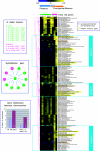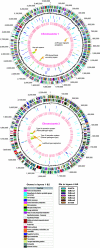Structural flexibility in the Burkholderia mallei genome
- PMID: 15377793
- PMCID: PMC521142
- DOI: 10.1073/pnas.0403306101
Structural flexibility in the Burkholderia mallei genome
Abstract
The complete genome sequence of Burkholderia mallei ATCC 23344 provides insight into this highly infectious bacterium's pathogenicity and evolutionary history. B. mallei, the etiologic agent of glanders, has come under renewed scientific investigation as a result of recent concerns about its past and potential future use as a biological weapon. Genome analysis identified a number of putative virulence factors whose function was supported by comparative genome hybridization and expression profiling of the bacterium in hamster liver in vivo. The genome contains numerous insertion sequence elements that have mediated extensive deletions and rearrangements of the genome relative to Burkholderia pseudomallei. The genome also contains a vast number (>12,000) of simple sequence repeats. Variation in simple sequence repeats in key genes can provide a mechanism for generating antigenic variation that may account for the mammalian host's inability to mount a durable adaptive immune response to a B. mallei infection.
Figures


References
-
- Neubauer, H., Meyer, H. & Finke, E. J. (1997) Rev. Int. Services Sante Forces Armees 70, 258–265.
-
- McGilvray, C. D. (1944) Can. J. Public Health 35, 268–275.
-
- Alibasoglu, M., Yesildere, T., Calislar, T., Inal, T. & Calsikan, U. (1986) Berl. Munch. Tierarztl. Wschr. 99, 57–63. - PubMed
-
- Sharrer, G. T. (1995) Agric. Hist. 69, 79–97. - PubMed
-
- Christopher, G. W., Cieslak, T. J., Pavlin, J. A. & Eitzen, E. M., Jr. (1997) J. Am. Med. Assoc. 278, 412–417. - PubMed
Publication types
MeSH terms
Associated data
- Actions
- Actions
Grants and funding
LinkOut - more resources
Full Text Sources
Other Literature Sources
Molecular Biology Databases
Miscellaneous

